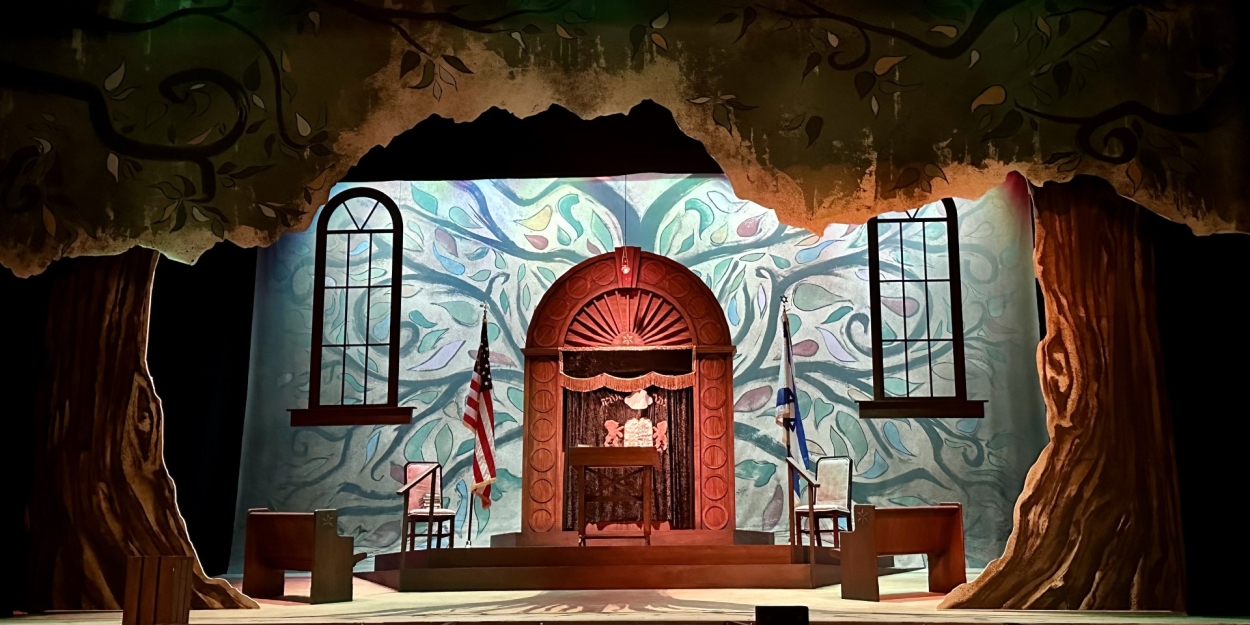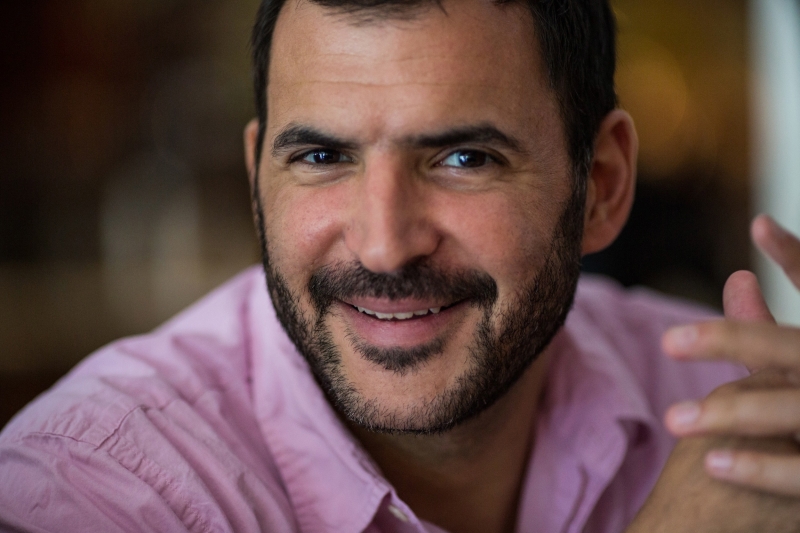Feature: TREE OF LIFE at White Theatre
Although entirely fictional, the play was inspired by a similar 2018 event at an Ottumwa Iowa synagogue covered by Wishna as a reporter.

The White Theatre presents a world premiere production of “Tree of Life,” a new two-act play, by Kansas City career writer and playwright Victor Wishna. “Tree of Life” documents the journey of a sacred “Torah” that has rested in the arc of a small-town Iowa synagogue over more than a century.
Although entirely fictional, the play was inspired by a similar 2018 event at an Ottumwa Iowa synagogue covered by Wishna as a reporter.
The “Tree of Life” cast features Victor Raider-Wexler, Greg Butell, Jordan Fox, Patricia Carrillo, Sarilee Kahn, Sophia Payton, Marshall Rimann, Margaret Shelby, and Kathy Breeden. The play is directed by Jonah Greene.

Photo by Eric Cheng
I had the privilege of meeting with the playwright, Victor Wishna, prior to the opening and discussing his new work. Wishna, it turns out, is a tall, friendly, youngish man with a growing family. He attended Shawnee Mission Schools and Stanford University. After his undergraduate years, Wishna pursued a writing career in New York City for twelve years while simultaneously earning an MFA at New York’s New School University.
Wishna said:
“Journalistic writing in New York City at the turn of the twenty-first century was not exactly a growth industry. “I freelanced and even had my own LLC doing various writing projects before becoming Chancellor’s Special Assistant at the Jewish Theological Seminary.
When I was ten years-old, I received a book about how to write a play. Of course, I didn’t do anything with it then.
While in New York, I wrote about theater and other things. With Ken Collins, a photographer friend, we wrote a book “In Their Company: Portraits of American Playwrights.” It is a book with photos and interviews with sixty-one great American Playwrights. We spoke to everyone from Edward Albee to Wendy Wasserstein; Neil Simon and August Wilson were interviewed.
The book was like a master class in playwriting. I got to sit down and talk with them and find out why and how they do what they do. It was like a graduate course in playwriting except at that point I wasn’t doing it.
I was kind of jealous. I mean I wanted to do what they were doing. “Here’s the most amazing thing,” “These people were flattered to be included in the book.”
Wishna is perhaps too humble when he talks about the publications who have accepted his work. Wishna has written for the Wall Street Journal, the Baltimore Sun, the Miami Herald, New York Post, and other major publications. He is now a regular contributor to KCUR-FM, Kansas City’s NPR affiliate.
“Tree of Life” began as a random writing assignment in 2018. Wishna was assigned to cover the closure of B’Nai Jacob, a small synagogue in Ottumwa, Iowa. The question arose would happen to the synagogue’s holy books?
One of the Ottumwa synagogue’s “Torahs” was gifted to a small temple in the South American country of Paraguay via a joint suggestion of Rabbi Esther Hugenholtz of Iowa City (who delivered B’Nai Jacob’s final sermon) and Oklahoma Rabbi Juan Mejía.
The two Rabbis are friends and happened to meet shortly after Hugenholtz’s final sermon. Together they suggested the transfer of the holy book to Latin America.
The story of the closure of this small-town temple and its international donation formed the nut of an idea that initiated a six-year journey of discovery for Victor Wishna.
Victor Wishna enjoyed the good fortune of marrying a girl, Annie, who he met in NYC, also from Kansas City and together they started a family.
Anyway, when my wife and I moved back to Kansas City in 2010. I figured, what the Heck, I want to write plays. My first theater piece was written for the Barn Players short play festival.
The three characters were greyhound racing dogs and the plot was about their last race before the dog track where they raced was closed down.
I got a little taste of success and then continued to get more involved. I had a play produced at the Living Room Theater here in Kansas City.
As a dramatist (and comedian), Wishna has composed nearly a dozen plays. His short play “Thank You for Meeting Me Here,” about students confronting antisemitism, is currently touring high schools in the Kansas City area and beyond.
Another Wishna play “DNR” was recently produced at The Living Room Theatre in Kansas City. The play was named a semi-finalist in the Blue Ink Playwriting Competition at the American Blues Theater in Chicago.
His full-length play, “Shearwater,” was selected as a winner of the Panndora’s Box Festival of New Works in Long Beach, Calif., and a finalist in Playhouse on the Square’s New Works @ The Works Playwriting Competition in Memphis.
“Tree of Life” begins with a first meeting between Iowa senior congregant Ken (Victor Rader-Wexler) and Marianela (Patricia Carrillo). Marianela is a graduate student at the University of Iowa. She has been directed to Ken by a professor known in common.
Wishna explained part of the development process.
When writing the play, you kind of ask yourself, if you had your choice of famous actors to play a part. I knew the show would be performed first in Kansas City and I kind of heard Victor’s voice in my head and then with other people from my own family.
Victor is an accomplished Equity actor in a class of his own. He has a huge history in film, stage, and TV. The White Theatre made a special arrangement to have him in the show. It was kind of like a dream to work with Victor on this.
There is an element of time warp to certain parts of the show Another neat thing about being the playwright is because you don’t really have to explain many things in the show that can be left up to the director and the designers to manage transitions and how they are going to play onstage.
I’m grateful to see the amount of resources being put into this production. I think it’s great they are creating a new works slot in their annual program.
After a table read and a workshop production in March and certainly from a design and a production aspect, conversations from those steps changed some of the arcs of the characters.
Wishna said he would love for the play to have a life in other places after this production closes.”
I saw a way to tell this story that touched on so much of Jewish history. These rediscovered Sephardic roots in South America and the rise and disappearance of small Jewish communities in the Midwest and the rural west. This is not the Holocaust story, but I think it has something to say.
Within a month of finishing the first draft, it was submitted to a Jewish Plays Project out of New York, and it was third out of the top ten finalist cohort. It was exciting to see that it was well received. I hope it may have a broader appeal.
“One of the things I think is wonderful about theater is it’s a collaborative effort. I was excited to write something that was an acceptable blueprint for a play and I’m excited to see what happens when a director and actors and all the other people that are involved from a technical standpoint take that and make something out of it.”
“Tree of Life” will run in the Lewis and Shirley White Theatre, a top quality, five hundred seat proscenium performing arts venue that hosts top quality community theater and touring productions. It has also made a commitment to annually premiering new works.
“Tree of Life” opens Saturday, September 14 and continues through Sunday, September 22. Tickets are available at https://www.thejkc.org/events/white-theatre.
______
This brings us back to Ottumwa Iowa in 2018.
A little explanation is necessary.
There are two major groups of people who practice the Jewish faith. One group, the Sephardic, come from Spain and the Mediterranean area. North American Jews emigrated mainly from another group called the Ashkenazi. They came from more northern and central parts of Europe.
Most Ashkenazi Jews before World War II emigrated to North America to escape persecution and pursue a better life. Specifically, many traveled from the pre-Soviet Russian Empire and fled after the assassination of the Russian Czar Alexander II in the 1880s.
By the 1930s, almost a third of America’s then 3.5 million Jews lived in cities with 1000 residents or less. Hundreds of synagogues like B’nai Jacob existed across America outside the big cities. These congregations were peopled by professionals, bankers, merchants, butchers, and jewelers of all sorts.
The congregants prospered. Their children pursued higher education and did not return to those small towns because of limited opportunities. Most showed no interest in continuing their parent’s businesses. Ownership of the businesses consolidated over time with larger enterprises. Small town Jewish congregations shrank until a ten-person minion could no longer be assembled. Eventually, the synagogues closed.
Meanwhile, the Sephardic saga in the New World traces its roots to the same year that Christopher Columbus was credited with the discovery of America in 1492. It was the time of the Spanish Inquisition.
Jews living on the Iberian Peninsula in the 1500s were offered a stark choice. Either convert to Christianity, emigrate, or face death by execution. At this point in time, Jews may have contributed up to twenty-five percent of the entire population of Spain and Portugal. Not surprisingly, many became Conversos (New Christians) or emigrated or both.
Most conversos in Latin America identified as Catholic. Yet some mysteriously retained some elements of their former faith. DNA testing availability has allowed for the rediscovery of Jewish roots and encouraged some secondary re-conversions of these Crypto-Jews back to the faith of their distant ancestors. A few have re-established synagogues in their home countries.
The nation of Spain has (since 2015) offered Spanish citizenship to those with Sephardic ancestry in an effort to atone for the Inquisition.
The Torah:
In the Jewish tradition, a holy book “Torah” is sacred. It resides in an arc under the watchful eye of an eternal light. “Torah” relates the law as given to Moses on Mt. Sinai.
It is not unusual for synagogue buildings to be closed or be upgraded, and for their sacred scrolls to be moved or donated or sometimes even buried with great ritual.
A new Torah is extremely expensive. It is a hand lettered (in Hebrew) document meticulously printed and proofread on Kosher animal skins. One might almost liken them to a medieval illuminated manuscript. They can take up to a year to produce and cost between $30,000 and $50,000.
The fledgling synagogue in Paraguay could not afford the price of a new Torah and accepted a gift from B’Nai Jacob in Ottumwa. Organizations exist to facilitate these kinds of transfers.
Comments

Videos

